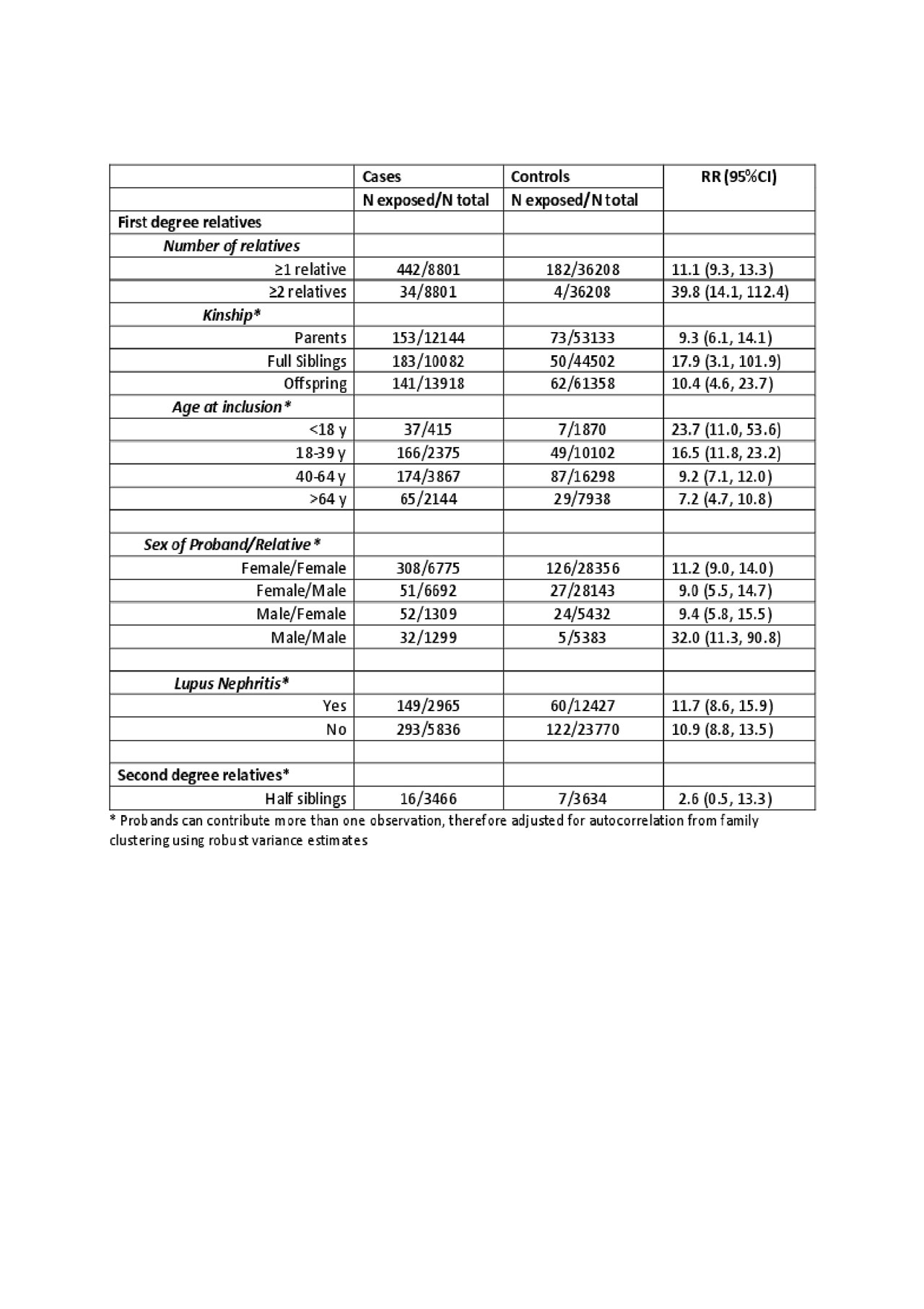Session Information
Date: Monday, November 11, 2019
Title: Epidemiology & Public Health Poster II: Spondyloarthritis & Connective Tissue Disease
Session Type: Poster Session (Monday)
Session Time: 9:00AM-11:00AM
Background/Purpose: Previous studies examining the relative risk (RR) associated with having a first degree relative (FDR) with systemic lupus erythematosus (SLE) were small and few investigated different proband-relative relationships nor stratified by proband characteristics, which is likely important when studying a heterogenous disease such as SLE. Our goal was to estimate the familial RR and heritability of SLE stratified by age at onset, sex and kinship in a large population-based sample.
Methods: We conducted a case-control-family study using Swedish nationwide registers. Proband SLE cases were identified from the National Patient Register using ICD codes for SLE (≥2 visits, ≥1 in specialist care (internal medicine, pediatrics, rheumatology, dermatology, nephrology); 1971-2016; n=8801). Lupus nephritis was defined using ICD codes for lupus-related kidney disease (ICD-10 N00-N06, N16.2, N16.4, N16.8, N17-N19, N26, M32.1) Proband controls were matched to each case 5:1 on age, sex and residential location. FDRs and half siblings were identified from the Multi-Generation Register and SLE in relatives was identified the same way as for cases. Conditional logistic regression models estimated RRs for SLE associated with having an FDR with SLE. Models were stratified by age at onset, sex of the proband/relative, and lupus nephritis. Robust variance estimates were used to calculate 95% confidence intervals (95%CI) to account for correlated data. Heritability was estimated using tetrachoric correlations among first degree relatives and prevalence estimates for our population.
Results: 5% of proband cases had ≥1 relative with SLE compared to 0.5% of controls. The RR for SLE associated with having ≥1 FDR with SLE was 11.1 (95%CI 9.3, 13.3; Table). The RR was higher if ≥2 FDRs had SLE (39.8; 95%CI 14.1, 112.4) and lower if a half sibling had SLE (RR 2.6; 95%CI 0.5, 13.3). RRs were higher for SLE diagnosed at a younger age (< 18y RR 23.7; 95%CI 11.0, 53.6) and in male proband/male relative kinships (RR 32.0; 95%CI 11.3, 90.8), although this was based on small numbers. There was no considerable difference in the association when stratified by lupus nephritis status. Heritability was 61% (95%CI 58, 64).
Conclusion: Having a first degree relative with SLE is associated with an 11-fold increased risk of SLE, making it a very strong risk factor for the disease. The risk is highest for pediatric SLE and decreases with increasing age at diagnosis. There were no large differences in risk by lupus nephritis phenotype, kinship, or sex. The male proband-male relative association was the highest, although this was based on small numbers. 61% of the phenotypic variance of SLE is attributable to genetic factors.
To cite this abstract in AMA style:
Arkema E, Rossides M, Sjöwall C, Svenungsson E, Simard J. Heritability and Familial Risk of Systemic Lupus Erythematosus in Sweden: A Population-based Case-control Study [abstract]. Arthritis Rheumatol. 2019; 71 (suppl 10). https://acrabstracts.org/abstract/heritability-and-familial-risk-of-systemic-lupus-erythematosus-in-sweden-a-population-based-case-control-study/. Accessed .« Back to 2019 ACR/ARP Annual Meeting
ACR Meeting Abstracts - https://acrabstracts.org/abstract/heritability-and-familial-risk-of-systemic-lupus-erythematosus-in-sweden-a-population-based-case-control-study/

